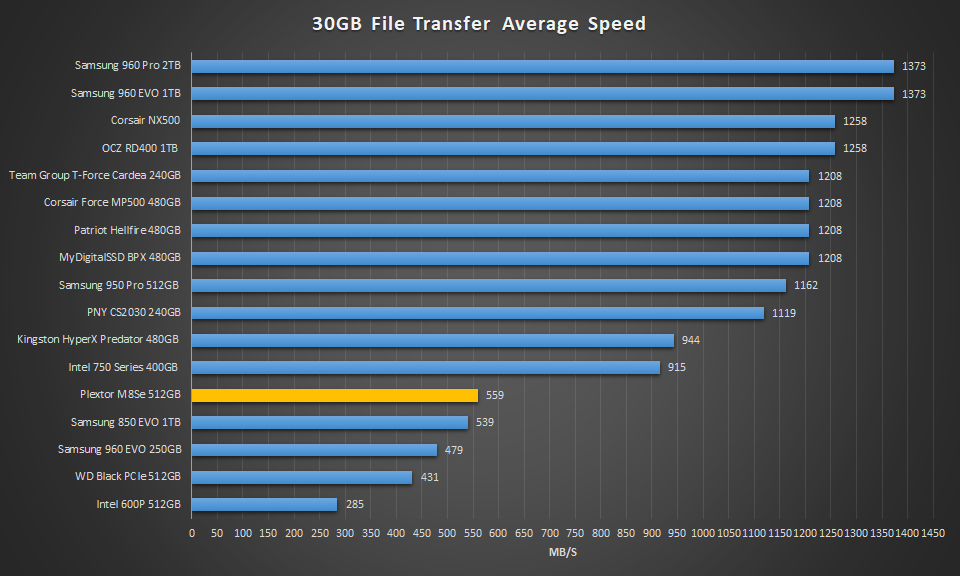REAL WORLD FILE TRANSFER
We also wanted to see how performance was in a real-world use when transferring large files to the SSD. For this test, we are going to simply stress write performance by transferring over a 30GB folder of movies off of a 512GB Samsung 950 Pro to the test SSDs and time how long it takes. Once complete we can calculate the average speed.
Here we see that the write performance averaged out to about 560MB/s when copying over our 30GB test folder. That, surprisingly, ranks it above the Samsung 960 EVO in addition to the WD Black PCIe and Intel 600P.
HDTUNE
HD Tune is a Hard Disk Utility with many functions from error checking, health testing (S.M.A.R.T.), and of course benchmarking. To build upon our real world write test we also looked to see where the write speeds leveled off to by using HD Tune Pro. If SLC caching is being utilized, this test will typically show it.
While we knew write performance slows down once the cache runs out on this SSD, we didn’t know just how poor write performance would be. After all, our 30GB transfer seemed to be acceptable. But, it turns out that it averages about 30MB/s give or take once that cache is full. For us, this is disappointing.
REPORT ANALYSIS AND FINAL THOUGHTS
Things were looking good for the Plextor M8Se at the beginning of this review. With the larger DRAM buffer and strong performance in our early benches, the M8Se put on a good show. Sequential speeds matched its rated specs of 2.45GB/s read and 1GB/s write. It reached 270K IOPS read and almost 170K IOPS write. QD1 performance was very good, exceeding that of the Samsung 960 EVO even during 4K read. But, this was just the beginning.
During PCMark 8, the Plextor M8Se did well for a planar TLC SSD. It outperformed the WD Black PCIe and Intel 600P, undoubtedly from the use of a larger DRAM cache, however, it’s performance in PCMark 8 extended left much to be desired. During PCMark 8 extended, the M8Se delivered dismal results. It was at this point we could see that there was work left to be done on the firmware management side of things. After a heavy bombardment of testing the M8se just couldn’t recover as other SSDs had. Results fluctuated vastly and consistency was not to be seen anywhere except in the fact that its performance was consistently inconsistent.
Moving on to our real-world file transfer we could see the utilization of an SLC cache was obvious because the speed of the 30GB write transfer averaged 560MB/s. This, however, didn’t tell us how slow the performance was after the buffer was full. To see this, we proceeded to test with HDTune and wrote to the entire capacity of the drive. Its results were shocking, to say the least. It turned out that the M8Se will drop to about 30MB/s once the write buffer is full. While this is unacceptable to some, especially those who are into heavy write workloads such as video editing and storage enthusiasts, for most, this performance will never be seen. So, unless you plan on bombarding the SSD with lots of writing, this should be of no concern for the majority.
FINAL THOUGHT
The M8Se comes in a variety of options and capacities to cater to the many different customers looking to upgrade their storage. Although we didn’t have access to the M8Se SKUs that featured heatsinks, we must admit that their design is quite stylish. On the other hand, it can be seen as a bit overkill for an SSD that doesn’t deliver such great sustained write performance as we saw in testing and just another option for those who focus on looks.
For those with an HDD looking to upgrade to an SSD, the M8Se will not disappoint. This M.2 PCIe NVMe SSD delivers a lot of performance in a small package. Multi-GB reads, 1GB/s write potential, and access times that are magnitudes faster than what one could ever expect out of a mechanical hard drive. For those looking to grade from a SATA SSD to a new PCIe NVMe SSD, this one ranks above both the Intel 600P and WD Black PCIe as can be seen in PCMark 8’s standard run results. So, again, it will be a fine option to upgrade to, it’s just on the low-end of the spectrum. If you are looking to do a lot of heavy writing to the drive, this, just as many other TLC SSDs we have tested before, is not the best choice. We would highly recommend an MLC based product to cope with such a workload demand. Otherwise, it is plenty fast for the average user.
The main thing holding the M8Se back truly isn’t its write performance, it is the price. After looking at what most other NVMe SSDs are going for, we just can’t recommend it to our readers when there are so many better options out there for the same and even cheaper prices at this time. At least they could have given it a 5-year warranty or developed a value-adding software at their current prices. Until it can compete in terms of pricing, look elsewhere.
 The SSD Review The Worlds Dedicated SSD Education and Review Resource |
The SSD Review The Worlds Dedicated SSD Education and Review Resource | 


Curious as to why the read performance in the ATTO benchmark drops off at the highest queue depths.
probably cause the heat